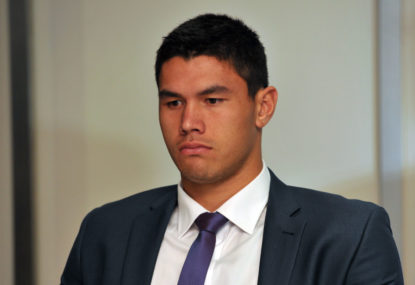Sivo brain snap leaves Arthur shaking his head as Parra throw away big lead to lose AGAIN
Brad Arthur must wonder what he has to say to his team anymore. With his job under huge pressure, his Parramatta side managed to…

I can’t remember a week where there hasn’t been club, fan, or commentator in upheaval over a decision at the NRL judiciary.
The discipline was too light, too heavy, didn’t meet the crime, or the precedence of other cases has been disregarded.
This week, the Cowboys are ruing the hefty suspension of Tariq Sims, as they face a side who some feel are lucky to have the likes of Aidan Guerra lining up.
It’s a tough pill to swallow, clubs have paid big bucks for their rosters, and having players out on suspensions for what may be considered unfair rulings is a big cost to a side’s hip pocket and premiership chances.
Yet there are three key reasons why inconsistency will continue, and has to be accepted as a part of the game.
Intent is hard to judge
One of the biggest difficulties for the panels is to determine malice. There’s no doubt that there should be an increased suspension handed to a player that has in some way deliberately tried to hurt or injure another player, or deliberately broken the rules. But as these incidents are happening in the heat of battle in a contact sport, intent is a hard topic to judge.
The difference between a player’s arm getting twisted in a tackle, and a ‘chicken wing’ is almost impossible to discern. A dozen people can watch the same incident and have a dozen different interpretations.
As a result, there’s a lack of consistency on penalties based on determining the intent.
Injury affects decision
You don’t need to look much further than the incident of the year for proof of this one.
Jordan McLean copped seven weeks for his tackle on Knights back-rower Alex McKinnon. There have been several worse tackles, both with regards to intent and recklessness, that have only been penalised for four or five weeks.
While there is no denying the result was tragic, Alex’s condition no doubt affected the judgement.
The simple fact is that injuries sustained by players will generally increase the ban handed out by the judiciary, and this inconsistency has been questioned by clubs.
Players carry stigmas
Certain players, not just at the judiciary, but also from an on-field perspective, tend get harsher wraps. The likes of enforcers Jared Waerea-Hargreaves, Sam Burgess, and even back retired Englishman Adrian Morely, all seem or seemed to cop an extra week here or there.
While carry-over points are there to ensure repeat offenders are duly punished, the effect of the players ‘persona’ can, but shouldn’t, influence the punishment laid down. This will always be a point of conjecture for clubs who sign such players, and is perhaps an unfortunate trade-off for their intimidating presence.
There are also thoughts that some players make tackles ‘look worse’. There’s a question over the way big Greg Inglis falls, he often seems to get himself in a more awkward position when being lifted, and historically, players with more upright styles of hitting up, a la Martin Lang, make it difficult or look worse for a tackler. As a result, tacklers can find themselves on report and suspended even if they utilise the same technique in other instances.
Human involvement will always result in inconsistencies. Emotions, situations and preconceived notions effect the decisions made. The NRL have a fastidious review process, whereby they regularly look at the consistency and penalties handed out.
The system will continue to cop flack, but it’s the system we have to deal with.